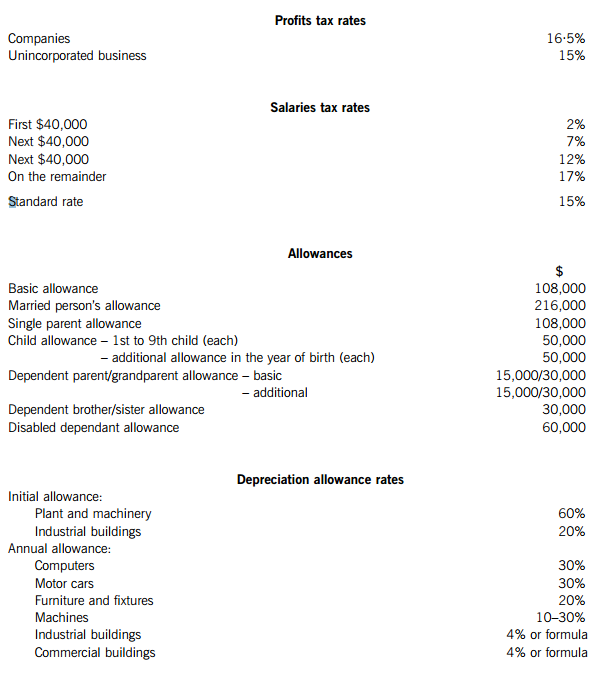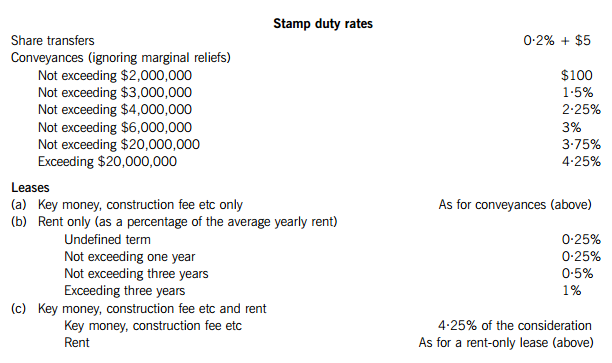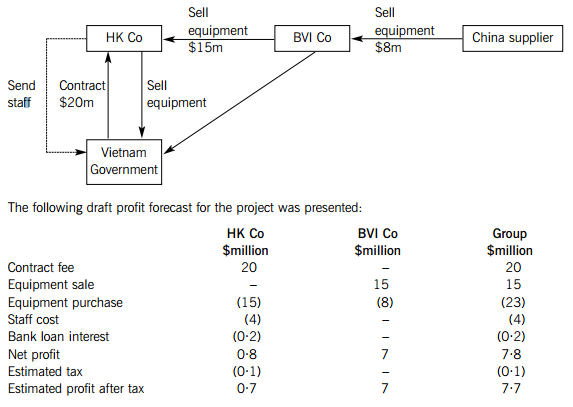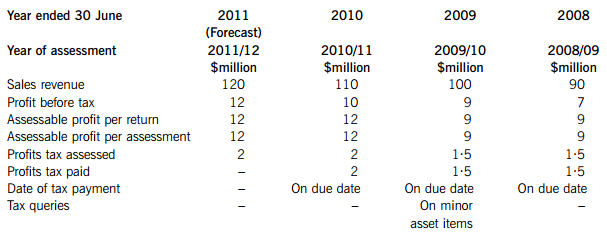 重要提示:
请勿将账号共享给其他人使用,违者账号将被封禁!
重要提示:
请勿将账号共享给其他人使用,违者账号将被封禁!
 题目内容
(请给出正确答案)
题目内容
(请给出正确答案)
SUPPLEMENTARY INSTRUCTIONS
1. You should assume that the tax rates and allowances shown below will continue to apply for the foreseeable future.
2. Calculations and workings should be rounded down to the nearest HK$.
3. Apportionments need only be made to the nearest month, unless the law and prevailing practice require otherwise.
4. All workings should be shown.
TAX RATES AND ALLOWANCES
The following 2010/11 tax rates and allowances are to be used in answering the questions.


1.
HK Engineering Co Ltd (HK Co), a Hong Kong-incorporated company carrying on business in Hong Kong, was successfully awarded a contract in Vietnam to help the Vietnam government with a new water plant project. A meeting has been scheduled with the Vietnam government’s representatives to discuss the details of the main contract. Prior to the meeting, the project manager, Mr Man, called for a meeting with other senior management staff, the details of which are as minuted below. All amounts are in HK$.
Minutes of Meeting on 1 June 2010 on Project Victory
Attendance:
Man (Project Manager)
FF (Finance Director)
TT (Treasurer)
EE (Chief Engineer)
1. Man briefly explained the scope of the work as required, including:
(a) the contract comprises two elements: supply of heavy equipment and the installation of the equipment on site;
(b) the total contract value is equivalent to $20 million covering both elements; and
(c) the duration of the project is estimated to be six months.
2. EE suggested that the equipment be purchased from one of their existing suppliers in Mainland China. Due to their long established relationship with this supplier, EE has confidence in negotiating the best terms and deal, with all the purchase orders and shipping documentation being dealt with directly in Hong Kong. The purchase cost is estimated to be around $8 million.
However, for the installation services, apart from employing local Vietnamese workers to perform. the on-site work, EE would need to send a team of experienced engineers from Hong Kong to Vietnam to supervise the work. As a result, the total staff costs for the project are estimated to be $4 million.
3. TT suggested that the $8 million purchase cost of the equipment be funded by the company’s current bank loan facility with interest at the rate of 5% per annum.
4. FF proposed the following structure using another member of the HK Co group, incorporated in the British Virgin Islands, BVI Co, in order to maximise the after-tax profit of the group:

5. Man appreciated the proposal explained by FF but questioned whether the structure would be challenged by the Inland Revenue Department as tax avoidance. Moreover, he is considering establishing a local subsidiary in Vietnam to sign the contract, as a start-up to expand HK Co’s business into the Vietnam market. FF agreed to solicit professional tax opinion on these aspects.
Required:
As the tax advisor of HK Engineering Co Ltd (HK Co), prepare a report for Mr Man addressing the tax issues set out below, including supporting calculations where appropriate.
(a) Assuming that a Vietnam subsidiary, wholly owned by HK Co, is established, the contract is to be signed by the Vietnam subsidiary and the equipment and staff are supplied by HK Co as outlined in point 2 of the minutes, advise on:
(i) The Hong Kong profits tax implications for HK Co with respect to the profits arising from the contract, together with any other matters on which you would recommend HK Co to obtain further advice; (4 marks)
(ii) How the supply of the equipment and staff should be dealt with in view of the current transfer pricing practice in Hong Kong. (8 marks)
Note: You are NOT required to comment on the Hong Kong-Vietnam tax treaty.
(b) Assuming that no Vietnam subsidiary is set up, and the structure proposed by the Finance Director (FF) as outlined in point 4 of the minutes is adopted, advise on:
(i) The Hong Kong profits tax implications for HK Co arising from the contract. You should specifically consider both the taxability of the contract value of $20 million, and the deductibility of the equipment purchase cost, staff costs and loan interest; (17 marks)
(ii) What the Hong Kong profits tax implications will be for BVI Co arising from the sale of the equipment to HK Co. (9 marks)
Professional marks will be awarded in question 1 for the appropriateness of the format and presentation of the report and the effectiveness with which its advice is communicated. (2 marks)
2.
Mr and Mrs Kwok are a married couple with no children. Mr Kwok has been working for a Hong Kong-listed company (the Company) since 1 August 2002. He had the intention to resign on 1 August 2010 but the Company had requested that he stay on for one more year. In recognition of his agreement to stay, the Company agreed to pay him an extra incentive of $50,000 on 1 August 2011. As the time is approaching, Mr Kwok is seeking professional tax advice on his tax position if he resigns effective from 1 August 2011 based on the following information:
Upon ceasing employment on 1 August 2011, Mr Kwok expects to receive the following final payments:
(1) A lump sum incentive payment of $50,000, as agreed in 2010, for Mr Kwok’s agreeing to extend his services for one year.
(2) An estimated amount of $100,000 representing his bonus entitlement in respect of the financial year 2011. This amount is estimated based on last year’s payment. The final figure will only be available in April 2012. Should the final figure exceed the payment of $100,000, the top-up will be paid to him in mid-April 2012. The Company has agreed that if the final figure is lower than $100,000 he will not be asked to pay anything back.
(3) Payment for leave not taken amounting to $20,000, including some leave days brought forward from 2010.
(4) Retirement benefit calculated in accordance with the rules governing the Company’s retirement plan which is duly registered under the Occupational Retirement Schemes Ordinance. Mr Kwok has met with the Company’s personnel manager, and he was asked to make a choice amongst the following options:
(i) leaving the Company by way of resignation (i.e. termination of service) and withdrawing his ‘leaving service benefit’ in the lump sum of $1,000,000;
(ii) leaving the Company by way of early retirement (subject to his supervisor’s consent) and withdrawing his ‘retirement benefit’ in the lump sum of $1,000,000 (same as the ‘leaving service benefit’ under (i) above);
(iii) leaving the Company by way of early retirement (subject to his supervisor’s consent) and withdrawing his ‘retirement benefit’ as a periodic pension in the amount of $10,000 per month commencing 1 August 2011 until his death.
Following his retirement, Mr Kwok will continue to serve the Company in the capacity of an independent consultant for a tenure of two years under the following terms:
(5) Mr Kwok will be obliged to provide services as and when required by the Company at an hourly rate of $1,000; but will be given advance notice of not less than 24 hours.
(6) Mr and Mrs Kwok are allowed to continue to occupy the Company’s staff quarters, subject to him continuing to pay the same rental contribution of $5,000 per month (see (10) below).
(7) At the expiry of the tenure, subject to the Company’s satisfaction with Mr Kwok’s service, Mr Kwok may be entitled to a gratuity of $10,000. Mr Kwok has also provided the following additional information:
(8) His annual taxable income reported in the tax return for the year of assessment 2010/11 is $1,000,000. He understands that when he is demanded to pay tax on his income for 2010/11, he will also be required to pay the provisional tax for 2011/12 based on the full-year income for 2010/11. He is concerned about the additional cash burden in meeting the provisional tax liability after ceasing employment.
(9) His monthly salary is $80,000 but he only receives $76,000 each month after deducting 5% as his contribution to the Company’s retirement plan. He understands that the Company is also obliged to contribute the same amount into the plan.
(10) He and his wife have been living in the Company’s quarter since August 2002. A monthly rental contribution of $5,000 has been deducted from his salary. The market rental of the quarter is $8,000 per month. Mr Kwok understands that he has been paying tax on this housing benefit but he has no idea about how the taxable value is calculated.
(11) His annual bonus for the financial year 2010 in the amount of $100,000 was received in April 2011.
(12) Mrs Kwok owns a property in Hong Kong and has been leasing it out for a monthly rental of $6,000. The property is still under mortgage and the monthly mortgage payment is $3,000, including $1,000 as interest. For tax reporting purposes, Mrs Kwok has each year declared the rental income of $3,000 per month and paid property tax thereon.
Required:
As his tax consultant, write a letter to Mr Kwok giving advice on the following:
(a) The general principles for determining the taxability of each item of final payment received by Mr Kwok upon his cessation of employment on 1 August 2011, assuming that he leaves the Company’s employment by way of resignation; that is, he chooses option (4)(i) above.
Note: You are NOT required to calculate the assessable/chargeable income or tax payable. (11 marks)
(b) The tax consequences, if any, to Mr Kwok if he chooses to leave the Company’s employment by way of retirement; and in this respect, whether his tax position would be different under the options of (4)(ii) and (4)(iii) above.
Note: You are NOT required to calculate the assessable/chargeable income or tax payable. (5 marks)
(c) The estimated tax positions of Mr and Mrs Kwok for the year of assessment 2011/12, and future years if applicable, based on the information available, together with any suggested actions available for Mr and Mrs Kwok’s consideration to help ease the cash burden required to meet their provisional tax liability for 2011/12 and/or improve their overall tax position in future years.
Notes:
(1) You should support your advice with calculations of assessable/chargeable income in so far as the information provided permits but are NOT required to calculate the tax payable.
(2) You should assume that Mr Kwok will keep 31 March as the ending date of his basis period. (12 marks)
Professional marks will be awarded in question 2 for the appropriateness of the format and presentation of the letter and the effectiveness with which its advice is communicated. (2 marks)
Section B – TWO questions ONLY to be attempted
3.
John Yuan is a PRC citizen working in the PRC. His brother, Peter Yuan, is a tax resident living and working in Hong Kong as a registered stockbroker under Part VI of the Securities Ordinance. Since 2008, Peter has been engaged in buying and selling shares listed in both Hong Kong and the US via internet banking. The share-trading is operated through two securities accounts, one in the name of Peter Yuan and the other in the name of John Yuan. Peter usually receives instructions or guidance from John through emails or telephone calls with regard to the identities of shares to buy or sell, the acceptable price range, the period of holding etc. However, at critical moments, he will exercise his discretion to maximise his brother’s interests or minimise his loss. Peter regularly collects updated market news and analysts’ reports and sends them to John. At the end of each month, Peter prepares a transaction summary for John showing the details of the transactions done on John’s account during the month. The average size of John’s portfolio per annum is around $20 million, and the average holding period for the shares is between 10 and 30 days. Since 2008, John’s portfolio has made a profit of around $2 million.
Required:
(a) Discuss whether or not John Yuan is liable to Hong Kong tax in respect of the profits arising from the trading of shares listed in Hong Kong and the US.
Note:
(1) For this part only, you are NOT required to discuss court case decisions in detail. Where applicable, only Departmental Interpretation and Practice Notes issued by the Inland Revenue Department should be relied upon.
(2) You are NOT required to examine in detail the impact of electronic commerce on the determination of source of profits. (10 marks)
(b) Assuming that Hong Kong tax is payable by John Yuan, advise whether the Inland Revenue Department can collect tax from Peter Yuan on behalf of John Yuan, and whether Peter Yuan is protected by the Inland Revenue Ordinance from any claims by John Yuan in respect of any tax paid on his behalf. (5 marks)
4.
(a) ‘It is a fundamental principle that stamp duty is charged on instruments, not on transactions.’
Required:
Comment on the effect of this statement, outlining the ways in which Hong Kong law ensures that certain transactions must be evidenced by a document in writing and giving a concrete example of how this principle can be used to avoid liability to Hong Kong stamp duty. (4 marks)
(b) The management of Tai Cheong Ltd (TCL) is considering acquiring all of the shares in Sun Cheong Ltd (SCL) for $500,000, which is the fair market value of these shares. SCL is a business competitor of TCL that is in financial difficulties; and has a substantial tax loss brought forward. Upon obtaining control of SCL, TCL will transfer part of its profitable retail business to TCL. SCL will then lease TCL’s retail shop in Mongkok from TCL. The term of the lease will be for six years and, under the lease agreement, SCL will pay 1% of the gross revenue from its retail business to TCL as the lease rental, subject to a maximum of $800,000 per annum. The gross revenue from the retail business is expected to be around $9 million per annum for the next few years.
Required:
(i) State the general rules governing the treatment of tax losses for corporations in Hong Kong; (3 marks)
(ii) Advise on the profits tax implications and stamp duty implications for Tai Cheong Ltd and Sun Cheong Ltd if Tai Cheong Ltd decides to acquire the shares of Sun Cheong Ltd and to lease the retail shop to Sun Cheong Ltd. (8 marks)
5.
Buying Co Ltd (Buying Co) is interested in acquiring all the shares in Selling Co Ltd (Selling Co) from its current shareholder, Mr Shum. The consideration will be based on Selling Co’s financial position as at 30 June 2011. In the course of conducting the tax due diligence on Selling Co, the finance director of Buying Co obtained the following extracted information:

In drafting the share sale and purchase agreement, the lawyer of Buying Co requested a tax indemnity from Mr Shum to the effect that, after the shareholding change, any extra tax cost suffered by Selling Co in relation to any transactions or events that occurred prior to the shareholding change would be indemnified by Mr Shum. However, this was not agreed to by Mr Shum’s lawyer. Instead, Mr Shum sent a letter to Buying Co advising that he guaranteed that all tax assessments have been finalised and Selling Co has no outstanding tax disputes with the Inland Revenue Department (IRD); and in case any tax queries were raised by the IRD in respect of the years prior to the shareholding change, he was prepared to take full responsibility to deal with the disputes with the IRD on behalf of Selling Co.
Required:
Advise the directors of Buying Co Ltd on any potential tax risks that may be faced by Buying Co Ltd in respect of the acquisition of Selling Co Ltd in terms of tax compliance and whether the guarantee letter from Mr Shum is sufficient and effective to protect Buying Co Ltd in the event of a tax challenge being raised for any prior year.
请帮忙给出每个问题的正确答案和分析,谢谢!
 更多“SUPPLEMENTARY INSTRUCTIONS1. You should assume that the tax rates and allowances shown bel”相关的问题
更多“SUPPLEMENTARY INSTRUCTIONS1. You should assume that the tax rates and allowances shown bel”相关的问题
第1题
he new premises in the
year ending 31 March 2009 and explain, using illustrative calculations, how any additional recoverable input
tax will be calculated in future years. (5 marks)
第2题
h the maximum
possible investment, borrowing to finance the subscription and the implications of selling the shares.
(7 marks)
Note: you should assume that Vostok Ltd and its trade qualify for the purposes of the enterprise investment
scheme and you are not required to list the conditions that need to be satisfied by the company, its
shares or its business activities.
第3题
invest in his company,
Vostok Ltd. He also requires advice on the recoverability of input tax relating to the purchase of new premises.
The following information has been obtained from a meeting with Gagarin.
Vostok Ltd:
– An unquoted UK resident company.
– Gagarin owns 100% of the company’s ordinary share capital.
– Has 18 employees.
– Provides computer based services to commercial companies.
– Requires additional funds to finance its expansion.
Funds required by Vostok Ltd:
– Vostok Ltd needs to raise £420,000.
– Vostok Ltd will issue 20,000 shares at £21 per share on 31 August 2008.
– The new shareholder(s) will own 40% of the company.
– Part of the money raised will contribute towards the purchase of new premises for use by Vostok Ltd.
Gagarin’s initial thoughts:
– The minimum investment will be 5,000 shares and payment will be made in full on subscription.
– Gagarin has a number of wealthy business contacts who may be interested in investing.
– Gagarin has heard that it may be possible to obtain tax relief for up to 60% of the investment via the enterprise
investment scheme.
Wealthy business contacts:
– Are all UK resident higher rate taxpayers.
– May wish to borrow the funds to invest in Vostok Ltd if there is a tax incentive to do so.
New premises:
– Will cost £446,500 including value added tax (VAT).
– Will be used in connection with all aspects of Vostok Ltd’s business.
– Will be sold for £600,000 plus VAT in six years time.
– Vostok Ltd will waive the VAT exemption on the sale of the building.
The VAT position of Vostok Ltd:
– In the year ending 31 March 2009, 28% of Vostok Ltd’s supplies will be exempt for the purposes of VAT.
– This percentage is expected to reduce over the next few years.
– Irrecoverable input tax due to the company’s partially exempt status exceeds the de minimis limits.
Required:
(a) Prepare notes for Gagarin to use when speaking to potential investors. The notes should include:
(i) The tax incentives immediately available in respect of the amount invested in shares issued in
accordance with the enterprise investment scheme; (5 marks)
第4题
e UK without
giving rise to a UK income tax liability. (2 marks)
第5题
nd/or provide him with
interest-free loan finance for this purpose without increasing his UK income tax liability; (3 marks)
第6题
ale of the paintings
can be minimised. (2 marks)
第7题
the instalments are
due and identify any further issues relevant to Galileo relating to the payments. (3 marks)
第8题
tax that will be suffered
on both the distributed and non-distributed profits of the non-UK resident investee companies where:
(1) there is a double tax treaty between the UK and the country in which the individual companies are
resident; and
(2) there is no such double tax treaty.
Note: you are not required to explain the position of the overseas resident branches. (6 marks)
第9题
tal treatment to
apply to the transaction. (4 marks)
第10题
shareholders over plans to
expand the company’s activities overseas. In order to resolve the position it has been agreed that Spica will sell her
shares back to the company. Once the purchase of her shares has taken place, the company intends to establish a
number of branches overseas and acquire a shareholding in a number of companies that are resident and trade in
overseas countries.
The following information has been obtained from client files and meetings with the parties involved.
Acrux Ltd:
– An unquoted UK resident company.
– Share capital consists of 50,000 ordinary shares issued at £1·90 per share in July 2000.
– None of the other shareholders has any connection with Spica.
The purchase of own shares:
– The company will purchase all of Spica’s shares for £8 per share.
– The transaction will take place by the end of 2008.
Spica:
– Purchased 8,000 shares in Acrux Ltd for £2 per share on 30 September 2003.
– Has no income in the tax year 2008/09.
– Has chargeable capital gains in the tax year 2008/09 of £3,800.
– Has houses in the UK and the country of Solaris and divides her time between them.
Investment in non-UK resident companies:
– Acrux Ltd will acquire between 15% and 20% of each of the non-UK resident companies.
– The companies will not be controlled foreign companies as the rates of tax in the overseas countries will be
between 23% and 42%.
– There may or may not be a double tax treaty between the UK and the overseas countries in which the companies
are resident. Where there is a treaty, it will be based on the OECD model treaty.
– None of the countries concerned levy withholding tax on dividends paid to UK companies.
– The directors of Acrux Ltd are concerned that the rate of tax suffered on the profits of the overseas companies
will be very high as they will be taxed in both the overseas country and in the UK.
Required:
(a) (i) Prepare detailed calculations to determine the most beneficial tax treatment of the payment Spica will
receive for her shares; (7 marks)

 警告:系统检测到您的账号存在安全风险
警告:系统检测到您的账号存在安全风险
为了保护您的账号安全,请在“上学吧”公众号进行验证,点击“官网服务”-“账号验证”后输入验证码“”完成验证,验证成功后方可继续查看答案!
